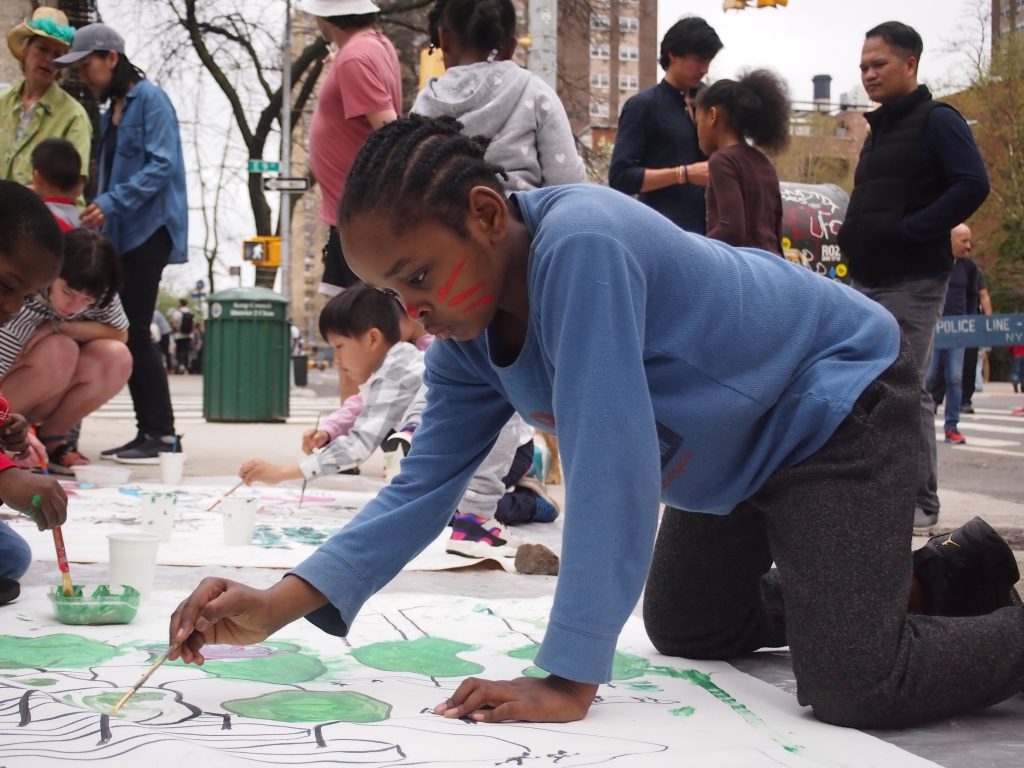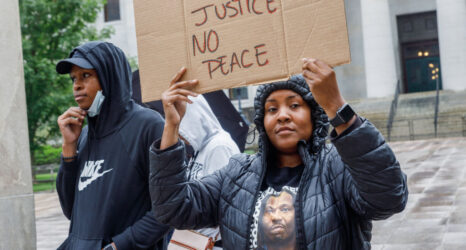Environmental activist and community organizer Felicia Young is passionate about using the arts to help New York City residents address climate change and demand government action.

Over the past several decades, community-organizer-slash-environmental activist Felicia Young has had several epiphanies about the importance of art in fomenting progressive social change. As the founder and executive director of Earth Celebrations, a 30-year-old New York City-based group that brings diverse constituencies together to support community gardens and promote urban ecology, Young is passionate about using the arts—dance, music, theater and an array of visual mediums—to help city residents address escalating climate change and demand government action in support of sustainable development.
Despite its focus on serious issues, fun is central to Earth Celebrations’ work—ranging from online and in-person workshops that teach participants to use sustainable materials like kelp, kombucha and mycelium to make costumes, puppets and sculptures; to an annual spring pageant that moves through Lower Manhattan to promote creative solutions to the burgeoning environmental crisis.
“Earth Celebrations blends traditional community organizing with urban planning, partnership-building and collaboration,” Young told Ms. “By bringing the arts into how we communicate our message, people develop an emotional connection to the science of climate change.”

In its earliest incarnation, Earth Celebrations focused on preserving the more than 60 small “vest-pocket parks” that had popped up on abandoned land on Manhattan’s Lower East Side in the 1960s and ’70s. “It was a regular David and Goliath story,” Young said. “Most of the gardens had been created by low-income people who were infused with community spirit. They had turned land devastated by crime and neglect into neighborhood hubs—but by the mid-1980s, the gardens were threatened because the city was facing a financial crisis and wanted to sell the land to developers.”
Young was outraged by the city’s devaluing of these green oases and called a meeting to bring local residents and organizational stakeholders together to talk about what they could do to derail the plan. The result was the 1994 formation of the Lower East Side Garden Preservation Coalition. In addition to organizing letter-writing campaigns and petition drives, they demonstrated and testified at public hearings. For 15 years, the coalition sponsored an annual Rites of Spring Procession to Save Our Gardens.
But Young did not stop there.
In 1996, when she and her Lower East Side Coalition colleagues learned other community gardens were being threatened—then-Mayor Rudolph Giuliani had announced plans to sell 800 gardens located throughout the five boroughs to real estate moguls—they brought people from every corner of the city together to form the New York City Coalition for the Preservation of Gardens.
The Coalition scored a major victory in 2002 when then-Mayor Michael Bloomberg transferred hundreds of targeted gardens to the city’s parks department. This removed the immediate threat—but Young told Ms., “We’re still pushing for the gardens to be designated as permanent parkland.” Still, she said, it was amazing that, with the stroke of a pen, a moratorium on the gardens’ imminent destruction was put in place.
It was a victory to savor, and while Young admits she is a natural organizer, she nonetheless credits several experiences with reinforcing her career choice. The first occurred when she was a teenage intern assigned to the African wing of the Metropolitan Museum of Art.
“I saw beautiful objects that were not meant to be seen in a museum, but were purposeful, made for rituals or agricultural purposes,” she said.
Secondly, she continued, after her first year at Skidmore College, she spent a summer working at Christie’s art auction house. “They sent me to the airport to pick up fancy clients and had me hold up pieces of art during the auctions,” she said. “I thought: If this is what working in the art world is, I’m not interested.”
Nonetheless, Young continued to study art history. A junior year abroad, with six months in France and six months in Italy, introduced her to artists who had created pageants in support of political objectives. “I began to see that art could exist in a pubic realm, outside of museums and galleries,” she said.
This idea got an additional boost when she learned of the Mbari, a Nigerian tribe that responds to calamity by creating ephemeral art projects, and by a four-month visit to her mother’s homeland, India, in late 1988 and early 1989. The trip introduced her to contemporary pageantry, including the annual Wedding of Meenakshi Festival in Madurai.
“There was a terrible drought that year in Madurai,” Young said, “and the government sent water tanks to the area. People filled their pots with the precious liquid. I assumed they’d use it for drinking, cooking, the essentials and was incredibly moved to see them using it to spray the festival sculptures. They made it clear that they do not see art as a luxury; it is fully integrated into their daily lives and spiritual practices.”
This idea that art is essential to everyday life stayed with Young and is infused into everything that Earth Celebrations does. Likewise, the importance of green spaces and gardens was underscored in the aftermath of 2012’s Hurricane Sandy, when, despite significant flooding, the Lower East Side gardens she’d helped to save absorbed a great deal of flood water.
“Gardens can be innovators for urban climate solutions,” Young said. “They can be places for composting, rain water catchment, food production, pollination, and provide air filtration. Trees and plants sequester carbon. These urban climate solutions connect to green roofs, vertical and solar farming, and waterfront and coastal resiliency projects—things we celebrate in our pageants.”

Pre-COVID, each yearly Earth Celebration brought hundreds of costumed dancers, singers, actors and banner-and-sign-carrying activists to 20 sites, including 12 gardens. Art filled the streets to support—or sometimes introduce—the creation and maintenance of sustainable ecosystems. Young calls it “art for learning and engagement.”
This year, on May 8, the group will hold a “pop-up pageant,” with several socially-distanced but site-specific performances that will be live-streamed. Young is not deterred by this necessary shift.
“Art is a bridge that can connect diverse people, making it possible for them to address pressing issues and mobilize,” she said, and nothing—not even a global pandemic—can change that.
Learn more about the Ecological City: Art & Climate Solutions Pageant on Saturday, May 8, 2021:
You may also like:





